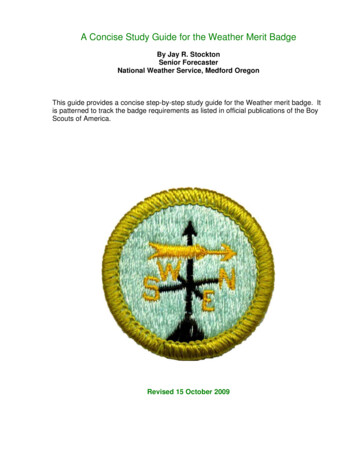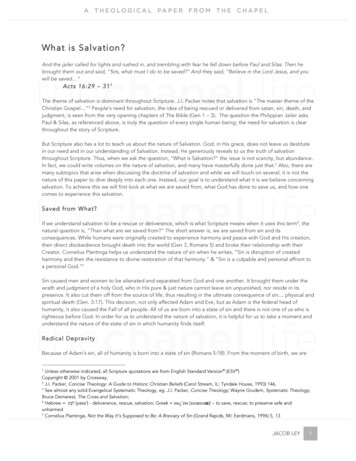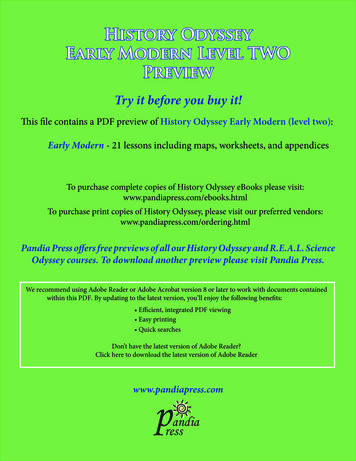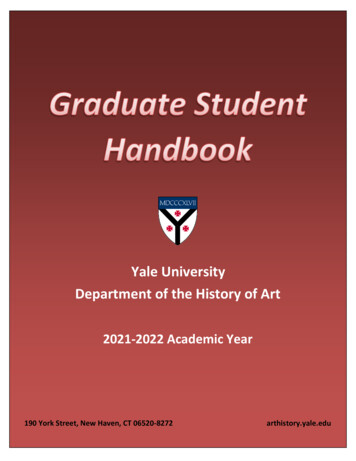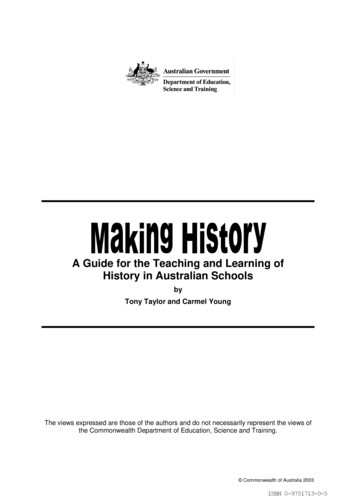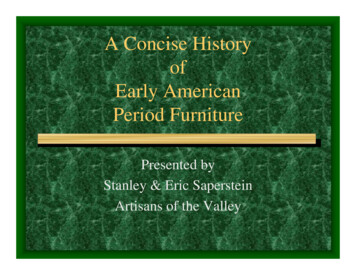
Transcription
A Concise HistoryofEarly AmericanPeriod FurniturePresented byStanley & Eric SapersteinArtisans of the Valley
A work in ProgressrdDraft October 23 , 2003Artisans of the Valley103 Corrine DrivePennington, NJ 08534609-637-0450 / 609-637-0452 faxwww.artisansofthevalley.com
Introduction Stanley D. Saperstein, Master– 30 Years Experience; Woodcarver, Joiner, Finisher,Designer, Cabinet & Furniture Maker, AntiqueConservationist.– Formal Seven Year Apprenticeship w/ C.N. Grinnell– Founder Artisans of the Valley, 1973.– Director of Preservation for The Swan Foundation, NJNational Guard Museum, Camp Olden Civil WarRound Table. Eric M. Saperstein, Journeyman– 15 Years Experience; Woodcarver, Joiner, Finisher,Designer, Cabinet & Furniture Maker, AntiqueArtisans of the Valleywww.artisansofthevalley.comConservationist.
Introduction Artisans of the Valley - Hand CraftedCustom Woodworking– Founded 1973 in Ewing, NJ and Moved toPennington in 1979– Transferred to Eric in 2001.– Specializing in Antique Restoration, PeriodReproductions, Woodcarving, and Furniture &Cabinetmaking.Artisans of the Valleywww.artisansofthevalley.com
Introduction Presentation Agenda Part I– Discuss and Define “Antiques”– Defining the great “Periods.”– Example Works Pilgrim Furniture Jacobean Period William & Mary Queen Anne Chippendale Federal Victorian Mission CountryArtisans of the Valleywww.artisansofthevalley.com
Introduction Presentation Agenda Part II– Identifying Antiques– Concepts of Preservation/Restoration– Philosophy of Restoration Museum Quality Family Heirlooms Investments Deciding Appropriate Conservation of a Piece– Purchasing Damaged Pieces– Evaluating Audience PiecesArtisans of the Valleywww.artisansofthevalley.com
Antiques – a Definition Formal Antique Furniture 1840 - Prior– Hand Made 1840 & Prior Confirmed hand craftedbefore the industrial revolution.– Exhibits linear saw markings– Signs of scraped surfaces – grain is burnished closed.– Hand carving– Veneer 1/16th inch, often irregular thickness.– Solid wood drawer bottoms, often beveled edges.– Dove tails and joint work are irregular– Cut nails, almost no screwsArtisans of the Valleywww.artisansofthevalley.com
Antiques – a Definition Formal Antique Furniture 1840 - Prior:– Wrought Iron & Cast Brass Hardware– Stains oil stain or no stain– Hand rubbed finish of shellac or occasionally naturaloil finish– Milk paints or natural dye pigmented stains.– Limited use of glue, Hyde glue only.– Paneled construction, ship lathing, tung and grove.– Solid wood backing and hidden components.Artisans of the Valleywww.artisansofthevalley.com
Antiques – a Definition Machine Era Furniture 1840 - 1930–––––––––Combined machine made joints & handCircular Saw Markings.Unfinished surfaces show planner “chatter.”Sanded surfaces.Veneering 1/32nd on less expensive piecesPlywood drawer bottoms.Machine – Rotary bit carving.Machine finger joints & dove tails.Artisans of the Valleywww.artisansofthevalley.com
Antiques – a Definition Machine Era Furniture 1840 - 1930––––––Use of screws, early blunt head later pointedStamped steel & brass hardwareStains oil stain or no stainHand or Spray Finish shifting to varnish later lacquerThicker oil based paints.Use of glue more common, introduction of artificialglues.– Often Plywood backing.–Artisans of the Valleywww.artisansofthevalley.com
Antiques – a Definition Mass Production 1930 – 1980 (Non-Antique)––––Wire nailsStamped plated hardware – brass, chrome, etcWiping surface layering stainsAlmost exclusive use of spray lacquer or urethanefinish– Oil into Latex paint.– Common use of glue, urethanes, polymers, etc.– Thin plywood or pressboard backings, introduction ofcardboard.Artisans of the Valleywww.artisansofthevalley.com
Antiques – a Definition Mass Production 1930 – 1980 (Non-Antique)–––––––––All Machine made joint workLittle saw markings, all surfaces planed and sanded.Polished sanded finish surfaceVeneering 1/32ndInitial use of artificial laminates 1950 forward.Introduction of fiberboard & pressboard.Plywood, drawer bottoms.Machine – Rotary bit carving.Often dowel jointed drawers or stapled drawers.Artisans of the Valleywww.artisansofthevalley.com
Antiques – a Definition Mass Production 1930 – 1980 (Non-Antique)– Phillips screws, engineered metal “brackets” andfasteners.– Wire nails,– Stamped plated hardware – brass, chrome, etc– Wiping surface layering stains– Almost exclusive use of spray lacquer or urethanefinish– Oil into Latex paint.– Common use of glue, urethanes, polymers, etc.– Thin plywood or pressboard backings, introduction ofcardboard.Artisans of the Valleywww.artisansofthevalley.com
Antiques – a Definition Mass Production 1980 – Present (CNC)––––––––––CNC computer controlled productionCNC Machine made joint workEngineered lumber and laminated structure.Materials recovery using “finger jointed” random units.No saw markings, all surfaces planed and sanded.Polished sanded finish surfaceVeneering 1/64th often paper backed.Extensive use of artificial laminates.Plywood, often fiberboard or masonite drawer bottoms.Machine – Rotary bit carving.Artisans of the Valleywww.artisansofthevalley.com
Antiques – a Definition “The Fake” Modern High quality reproductionreviling original craftsmanship, specifications, andqualities.– Often thin finishes, showing age, crazing in finishsurface and chemical aging of wood surface utilized.– All hardware appropriate to period, no use of modernfasteners, screws, etc.– No signs of modern glue.– Turnings are true round, not showing slight oblongfrom age.Artisans of the Valleywww.artisansofthevalley.com
Antiques – a Definition “The Fake” Modern High quality reproductionreviling original craftsmanship, specifications, andqualities.–––––A reproduction is NOT a fake, without false claims.Utilizes antique “aged” wood.Appropriate period tool markings.Hand unique irregular appearance.Shellac finish / natural oil using period processedsolutes.– Distressed appearance, showing standard age & wear.Artisans of the Valleywww.artisansofthevalley.com
Antiques – a Definition Mass Production 1980 – Present (CNC)– Often dowel jointed drawers or stapled drawers– Phillips screws, engineered plastic “brackets” andfasteners.– Wire nails, pins, and staples.– Stamped plated hardware – brass, chrome, etc– Single coat finishes almost exclusive use of coloredlacquer finish– Oil into Latex paint.– All glues polymer, urethane, etc no natural formulas.– Masonite, cardboard, or very thin plywood backings.Artisans of the Valleywww.artisansofthevalley.com–
Pilgrim 1620-1690 includes Jacobean, Tudor, &Restoration––––––Limited joint work, often wrought iron braces.Built by necessity for function, limited ornamentation.Limited skilled craftsmen & tooling available.Often crude, irregular – symmetry of parts skewed.Simplified English styles of English influence.Materials oak, pine, ash, walnut, all common EasternWoods.– Often painted black to faux ebony– Shellac & Oil Finishes.Artisans of the Valleywww.artisansofthevalley.com
Pilgrim Tools Priority on home andshelter building. Tools multi-purposehomes & furniture. Skill levels limited,knowledge of tools oftenscarce. Improvising and creativityto gain and use of allavailable materialsfunction prevailed.Artisans of the Valleywww.artisansofthevalley.com
Pilgrim Trestle Table American "Great Hall Table".Base has all edgeschampheredTop is supported ondecorated turnings joiningit to the central beamjoining the trestle ends.The top has breadboardends.No CarvingArtisans of the Valleywww.artisansofthevalley.com
Pilgrim (Tudor) Table Oak TableDouble Turned LegsPlank TopEdge Band OnlyArtisans of the Valleywww.artisansofthevalley.com
Pilgrim Chest Famous Brewster ChestOriginal Mayflower HeritageCirca 17th, Holland.Iron & Norway pineMost important Pilgrim Pieceuse as table, storage, seating. Dark reddish-brown paint Iron strap reinforced six boarddesign. Hardware includes insidehinges, typical of the era. Image Source:www.pilgrimhall.org/brechest.htmArtisans of the Valleywww.artisansofthevalley.com
Pilgrim Chair Winslow Arm ChairMaterials Red OakFraming of Squared partsMortise and tenon jointsThin rectangular panelsUpholstery velvet Image ns of the Valleywww.artisansofthevalley.com
Pilgrim Chair The Brewster ChairCirca 1630-1670American White Ash.Prominent turnings.Dowell joint work.Originally crafted by JohnEddy(1595-1684) Image Source:www.pilgrimhall.org/brechair.htmArtisans of the Valleywww.artisansofthevalley.com
Pilgrim Cradle Made in DuxburyCirca 1680-1720Maple and white Pine.sleeping baby visible fromalmost any position. Faux joint work, made ofsolid pine boards Ornamentation as turnings Often made by carpenters Image Source:www.pilgrimhall.org/F-cradles.htmArtisans of the Valleywww.artisansofthevalley.com
Pilgrim Bible Box Material Black Walnut. Housing the family Bible, records, specialdocuments, and evenprized seeds.Originals very rare today.Wooden hinges.Hand carving, oftenpersonalized with initialsor family crests.Pegged jointsNatural shellac finishArtisans ReproductionArtisans of the Valleywww.artisansofthevalley.com
Restoration Jacobean, 1603-1688 – Inspired byprimitive early American works by theoriginal colonists.– Name after James I and Charles I (1603-1649).– Commonwealth Style (1649-1660).– Carloean, after Charles II (1660-1688)Artisans of the Valleywww.artisansofthevalley.com
Restoration Jacobean, 1603-1688 – Inspired by primitive earlyAmerican works by the original tly oak, in massive, sturdy style.Flat chair surfaces, lines square and rectangular.Carving in low relief.Pegged mortise and tenon joints.Some veneering and inlay were usedCommon painted finished.Leather, tapestries, crewelwork, wool, linen, silk, and velvet.Heavy, spiral, and melon ball turningsKnobbed bun feet on chests and tables.Tables were rectangular in shape.– Gate-leg circular tables were introduced at this timeas ofwell.Artisansthe Valleywww.artisansofthevalley.com
Jacobean Jacobean, med after James I and Charles I (1603-1649).Commonwealth Style (1649-1660).Carloean, after Charles II (1660-1688)Oak, in massive, sturdy style, square and rectangular.Simple construction; pegged mortise and tenon joints.Flat chair surfaces, tables were rectangular in shape.Heavy, spiral, and melon ball turningsKnobbed bun feet on chests and tables.Carving in low relief.Some veneering and inlay introduced.Common painted finished.Use of leather, tapestries, crewelwork, wool, linen, silk, & velvet.Artisans of the ValleySigns of gate-leg circular tables appeared.www.artisansofthevalley.com
Jacobean Connecticut Chest Circa 1640Entirely of red oak.Mortis & tenon jointsWooden hinges on lid.Kalem Winslow, pilgrimcoffin maker, attributed.Commonly in theConnecticut river region.Hand carving face only.Jacobean stain & shellacfinish.Artisans ReproductionArtisans of the Valleywww.artisansofthevalley.com
Jacobean Chest Circa 1650Entirely of red oak.Bedside blanket chest.Common during Colonialtimes to store blankets,pillows, and otherpersonal items.Mortis & Tenonconstruction with panels.Wooden hinged lid.Hand carving face only.Artisans ReproductionArtisans of the Valleywww.artisansofthevalley.com
Jacobean Chair Jacobean Armchair Elaborate hand-carveddesign on almost allsurfaces. Leather upholstery Turnings and doweljoint work.Artisans of the Valleywww.artisansofthevalley.com
Jacobean Chair Jacobean ArmchairElaborate turningsLeather upholsteryTurnings and doweljoint work.Artisans of the Valleywww.artisansofthevalley.com
Jacobean Table Solid OakFeatured ApronExtensive CarvingSingle Turned legsLower beamDark finishPlank TopArched FeetArtisans of the Valleywww.artisansofthevalley.com
Jacobean Table I-Beam Trestle StyleSolid OakProminent ApronExtensive CarvingApronBanded TopMortis & Tenon JointsPegged ConstructionArtisans ReproductionArtisans of the Valleywww.artisansofthevalley.com
Jacobean Stamp Box American Stamp BoxCirca 1700 European Relic Box,which had been carvedfor centuries in Europeto house smallreligious relics such aslocks of hair. Artisans ReproductionArtisans of the Valleywww.artisansofthevalley.com
Jacobean Carved Desk Box Friesian Desk Box Circa 1720 The geometric carved patternPegged JointsSlat TopBeaded edgesBrass hingesArtisans ReproductionArtisans of the Valleywww.artisansofthevalley.com
William and Mary William and Mary, 1689-1725–––––––––Named for Mary Stuart, ascended in 1689.Dutch & French influence through Mary’s craftsmen.Walnut became the most widely used wood.Carving flowers, foliage, cupids, wreaths, and c-scrolls.Gilding, painting, and lacquering common.Marquetry and veneering common, including tabletops.Almost all turned pieces use the bell-shaped cup.Tables rectangular in shape, with "X" stretchers.Upholstery on almost all chairs and couches using tapestry, petitpoint embroidery, damask, brocade, velvet, and chintz.– Significant number of pieces imported from England.– The highboy was introduced.Artisans of the Valleywww.artisansofthevalley.com
William and Mary Side Table Side TableSolid oakVeneer FrontsBarley twist legsBeaded Plank topTeardrop pullsArtisans of the Valleywww.artisansofthevalley.com
William and Mary Chair Arm ChairLeather UpholsteryMahoganyExtensive CarvingCabriole LegsFlutingSolid BackArtisans of the Valleywww.artisansofthevalley.com
William and Mary Chair Side ChairLeather UpholsteryMahoganyExtensive CarvingCabriole LegsFlutingSolid BackArtisans of the Valleywww.artisansofthevalley.com
William and Mary Chest Chest on StandWalnutVeneeringTurned LegsNatural FinishArtisans of the Valleywww.artisansofthevalley.com
Queen Anne Queen Anne, 1725-1750– Often called the "first modern furniture period."– Cabriole leg almost universal on all pieces with cleanflowing lines.– Windsor and Bannister chairs.– Comfort and simplicity over ornament in all designs.– Primarily walnut, limited use of oak, pine, and ash.Mahogany towards the end of the period.– Carving, when used, is simple and low in relief:– Scalloped shell, which appears at the knees of cariolelegs, the top of the chair rails, or the center of seatframes. Acanthus and floral motifs.Artisans of the Valleywww.artisansofthevalley.com
Queen Anne Queen Anne, 1725-1750– Favored overstuffed fabrics: damask, brocade,velvet, & embossed leather.– Chair seats are shaped, feet are the Dutch padfood or the drake foot.– The gate-leg cabriole tables gained groundduring the period, and– The highboy was developed with cabriole legs.– Lowboys became popular dining room pieces.Artisans of the Valleywww.artisansofthevalley.com
Queen Anne Cupboard Corner CupboardHand Carved Shell.Material mahogany.Hand fluting.Split turnings.Raised panel doors.Solid wood Tung andgrove backing. Turned finials. Artisans ReproductionArtisans of the Valleywww.artisansofthevalley.com
Queen Anne Arm Chair Queen Anne CarvedArmchair.– Made in Philadelphia,1740-1760– Materials solid walnut.– Cabriole legs, clean linesscrolling arms and solidsingle slat back.– Sold for 1,980,000October 1999World Auction Record foran American ArmchairNew York, RockefellerCenterArtisans of the Valleywww.artisansofthevalley.com
Queen Anne Chest of Drawers The Sarah SlocumChippendale Block-andShell Carved Chest ofDrawers– Labeled by John Townsend(1732-1809)– Materials solid mahogany.– Shell carvings– Brass pulls– Sold for 4,700,000June 1998World Auction Record forJohn Townsend Furniture,NY Rockefeller CenterArtisans of the Valleywww.artisansofthevalley.com
Queen Anne Tea Table Artisans of the ValleyReproduction Queen AnneFloating Top Tea Table–––––Material solid walnutCirca 1705Spoon foot cabriole legsFloating piecrust top.Compound full cabrioleskirt work is hand carved.– Artisans ReproductionArtisans of the Valleywww.artisansofthevalley.com
Queen Anne Lowboy Artisans of the ValleyReproduction Lowboy– Materials solid walnut– Hand-carved drawerfront.– Solid brass pulls– Spoon foot cabriolelegs.– Artisans ReproductionArtisans of the Valleywww.artisansofthevalley.com
Queen Anne Highboy Highboy Chest of DrawersMaterials solid cherryDrawer front carvingsBrass hardwareDelicate cabriolespoon foot legsFretwork apronArtisans of the Valleywww.artisansofthevalley.com
Queen Anne Tilt Top Table Tilt top table.––––Materials Mahogany.Three legs.Simple spoon foot.Turned pedestal.Artisans of the Valleywww.artisansofthevalley.com
Queen Anne Drop Leaf Table Drop Leaf Table– Materials mahogany– Cabriole Legs– Gateleg design withdrop leaf.– Artisans ReproductionArtisans of the Valleywww.artisansofthevalley.com
Georgian Georgian, 1714-1806– Covers the reigns of George I, II, and III.– The period is the richest in terms of new stylesand famous craftsmen who invented the styles.– Early Georgian (1714-1740)– Late Georgian (1740-1806)Artisans of the Valleywww.artisansofthevalley.com
Georgian Georgian, 1714-1806– Early Georgian (1714-1740) Increased use of mahogany, the king of carvingwoods. The French and Oriental influences werestrong, Carving was heavy on many pieces. Lines were flowing, the use of the curve waspredominated.– Late Georgian (1740-1806) The great craftsmen were dominant. Broken into Chippendale, Sheraton, Adam, andHepplewhite.Artisans of the Valleywww.artisansofthevalley.com
Georgian Table Pedestal Table– Mahogany– Turned pedestal– Elegant, simple nocarving.Artisans of the Valleywww.artisansofthevalley.com
Georgian Chairs Georgian styleWindsor Chairs––––Ornate center slateTurned legsUse of dowel slatsElegance, lightappearanceArtisans of the Valleywww.artisansofthevalley.com
Georgian Chairs Georgian Side Chair––––––Solid MahoganyFretwork BackExtensive CarvingBall and Claw FeetCabriole LegsMoiré UpholsteryArtisans of the Valleywww.artisansofthevalley.com
Georgian Dresser Low Dresser––––––Solid OakTurned legsFretworkBrass PullsBeaded edgesPlatform baseArtisans of the Valleywww.artisansofthevalley.com
Georgian Slope front bureau–––––Slope FrontCirca 1800MahoganyBrass PullsSimple, no carvingArtisans of the Valleywww.artisansofthevalley.com
Chippendale Chippendale, 1714-1779– Thomas Chippendale first not a reigning monarch togive his name to furniture style.– He was both designer and master craftsman.– His "Director," published in 1754, opened a new era infurniture making and is still used today.Derived styles from a combination of English, French,and Chinese designs.– Graceful and well-proportioned.– Comfort was sometimes sacrificed for appearance.Artisans of the Valleywww.artisansofthevalley.com
Chippendale Chippendale, 1714-1779– Early cabriole legs; later pieces have strait legs.– Carving was the main type of decoration, favorite stylesbeing lions' paws, shells, acanthus, acorns, roses,dolphins, and scrolls.– Fretwork is used extensively,– Veneering occasionally.– Occasional guilding and lacquering.– Inlay, painting, or applied ornament is also used.– Practically all of Chippendale's furniture is mahogany.– Upholstered materials include leather in colors,brocade, velour, satin, and plush.Artisans of the Valleywww.artisansofthevalley.com
Chippendale Curio Curio Display Cabinet–––––Solid mahogany.Brass face hinges.Turned finialSimple moldings.Artisans ReproductionArtisans of the Valleywww.artisansofthevalley.com
Chippendale Secretary Chippendale Secretary– Artisans of the ValleyrestorationArtisans of the Valleywww.artisansofthevalley.com
Chippendale Tea Table Tea Table–––––––MahoganyCarved piecrust topPedestal BaseFluted turningsBall and Claw FeetCarved legsSold for 2,400,000January 1995Artisans of the Valleywww.artisansofthevalley.com
Queen Anne Chair The John CadwaladerHairy-paw Foot SideChair Extensive carving,fretwork, ball and clawfeet, curving apron. Fine upholstery. Sold for 1,400,000October 1999Artisans of the Valleywww.artisansofthevalley.com
Chippendale Armchair ArmchairMahoganyHighly ornate carvingBall and claw feetUse of rosettesCabriole legs andapron Leather upholsteryArtisans of the Valleywww.artisansofthevalley.com
Chippendale Armchair Side chairMahoganyHighly ornate carvingBall and claw feetCabriole legs & apronMoiré UpholsteryArtisans of the Valleywww.artisansofthevalley.com
Chippendale Desk Bookcase The Nicholas BrownChippendale Block-andShell Carved Desk andBookcase.– Attributed to John Goddard,– Sold for 12,100,000June 1989– Solid Mahogany– Brass Pools– Raised Panels– Shell Carvings– Finials– Ornate bonnet.Artisans of the Valleywww.artisansofthevalley.com
Chippendale Chest on Chest The Bliss FamilyChippendale Carved andBlocked Mahogany Cheston-Chest, 1770-1785– Sold for 1,200,000January 1997– Solid mahogany– Ornate Bonnet– Eagle Finial– Shell Carvings– FlutingArtisans of the Valleywww.artisansofthevalley.com
Hepplewhite Hepplewhite, 1750-1786– George Hepplewhite was a practical cabinetmaker whoproduced a simplified version of Louis XVI furniture.– Mahogany is the favored wood, with some satin-woodbirch and sycamore.– Lines and proportions are graceful, refined, and slender,though sturdy.– Chairs, settees, and other pieces are all built on asmaller scale than heretofore produced.– Slender, fluted legs with spade feet.– The graceful curve predominated, especially on chairbacks.Artisans of the Valleywww.artisansofthevalley.com
Hepplewhite Hepplewhite, 1750-1786– Dainty carving is sparingly used, consisting mostly ofclassical motifs, wheatears, ferns, husks, urns, rosettes,and Prince of Wales feathers, which he introduced.– Upholstery used was striped damask, silk, stain, and redand blue morocco with horsehair stuffing.– Hepplewhite’s favorite pieces were for the dining room.He popularized the sideboard, and the– Urns carved on all legs can always identify aHepplewhite sideboard.– His chairs featured open shield backs and had a verydelicate appearance.Artisans of the Valleywww.artisansofthevalley.com
Hepplewhite Pembroke Table Solid CherryInlaid apronTapered Legs.Typical the CT rivervalley from Hartfordup north through MA. Circa 1800Artisans of the Valleywww.artisansofthevalley.com
Hepplewhite Sideboard Bow Front SideboardSolid MahoganyMahogany veneerSatinwood inlayTapered LegsRound pullsArtisans of the Valleywww.artisansofthevalley.com
Hepplewhite Secretary Drop Front SecretaryVeneer FrontMahoganyPanel backTapered LegsArtisans of the Valleywww.artisansofthevalley.com
Hepplewhite Chair Painted Armchair Black painting withgold detail Ornate Upholstery No carving details No turningsArtisans of the Valleywww.artisansofthevalley.com
Adam Adam,1760-1792–––––Four Brothers Adam, Robert, James, and WilliamArchitects who turned into furniture designers.Developing a style to match the houses they planned.None were craftsmen, and others produced their work.They drew their inspirations from Green and Romanstyles and started a revolutionary era of carving.Artisans of the Valleywww.artisansofthevalley.com
Adam Adam,1760-1792– Slender, strait and curving lines, tapering legs leadingto flat surfaces.– Ornamented with painting, gilding, and inlay.– Occasional delicate low-relief carving is used withclassical Greek and Roman motifs, discs, fans,pendants, acanthus, pineapples, human figures, animalheads, and urns.– Upholstery brocade, damask, striped satin, and silk.– Mahogany and satinwood were favored woods.Artisans of the Valleywww.artisansofthevalley.com
Adam Commode Ornate Commode Mahogany ExtensiveSatinwood Inlay Limited or nocarving Square feetArtisans of the Valleywww.artisansofthevalley.com
Sheraton Sheraton, 1780-1806– Thomas Sheraton was a teacher, preacher, bookseller,fanatic, and pamphleteer in addition to being a furnituredesigner.– He was not a master craftsman, but he exerted atremendous influence on furniture craftsmen throughhis designs in his four books.– He jobbed out all orders to cabinetmakers, whoexecuted his designs.– Sheraton designed the first twin beds, roll-top desks,kidney-shaped tables, and dual-purpose furniture.– Slender, refined, delicate designs that are structurallyArtisans of the Valleysound and durable in construction.www.artisansofthevalley.com
Sheraton Sheraton, 1780-1806– Legs are slender, usually round, but never cabriole.– All pieces are well-proportioned, with strait linespredominating.– Ornamentation is simple, with inlay and marquetryused extensively.– Carving was classical, with ferns, ovals, urns, etc.– Favored woods were mahogany for dining rooms,bedrooms, and libraries; satinwood, rosewood, andpainted furniture for drawing rooms.– Upholstering fabrics were plain, striped, and floweredsatins, silks, and damasks.Artisans of the Valleywww.artisansofthevalley.com
Sheraton Library Table Library TableMaterial mahoganyBrass claw feetGold tooled leathertop. Plain Apron Fluted FeetArtisans of the Valleywww.artisansofthevalley.com
Sheraton Armchair Stick bow backArm chair.MahoganyTwisted back slatesSilk upholstery.Artisans of the Valleywww.artisansofthevalley.com
Sheraton Library Table Drop Leaf Probably maple withnicely turned legs. Painted decoration. New England origin.Ca. 1820-1830Artisans of the Valleywww.artisansofthevalley.com
Sheraton Library Table Sheraton Arm Chairs Paint and stencildecoration. Probably Bostonorigin. Ca. 1820-1830. Caning SeatArtisans of the Valleywww.artisansofthevalley.com
Federal Federal,1795-1830––––Dubbed the “American Period”First totally distinct American periodCredited to Duncan Phyfe.The period is broken into two sections: EarlyDuncan Phyfe, or Federal, and Late DuncanPhyfe, or American Empire.Artisans of the Valleywww.artisansofthevalley.com
Federal Early Duncan Phyfe– Distinctive style inspiration from Hepplewhite,Sheraton, and Adam.– Combined use of strait and curved.– Light carving, turning, fluting, reeding, acanthus,cornucopias, oak leaves, palm and laurel, wheat, andswags.– Upholstery silks, satin, brocade, wool, and horsehair.– Use X-crossed legs on chairs.– Exclusively MahoganyArtisans of the Valleywww.artisansofthevalley.com
Federal Late Phyfe––––––Turning to influence of the French Empire Style,Furniture becomes heavier and sturdier.Claw and bracket feet andHeavy pedestal tables.Metal mounts are used extensivelyIntroduction of walnut, oak, ash, hickory, and fruitwoodare used, mahogany still predominating.Artisans of the Valleywww.artisansofthevalley.com
Duncan Phyfe Roll Top Circa 1830.The first known roll top.Solid American walnut.Cloth backed hand spokeshaven solid wood slats.Extensive use of TurningsHand carving & flutingBrass hardware.Dovetail joint work.Artisans Reproduction.Artisans of the Valleywww.artisansofthevalley.com
Duncan Phyfe Pedestal Table Mahogany Classic Phyfe curvedfluted legs. Brass hardware andcasters Tooled leather surface Turned pedestal basewith three legs.Artisans of the Valleywww.artisansofthevalley.com
Duncan Phyfe Drop Leaf Mahogany, extensive figured San Domingo.D-shaped drop-leavesApron and urn shapedpedestal designDrawer at one end and afalse drawer at the otherAcanthus leaf carving,continuing to four saberlegsCarved paw feetBrass castors.Artisans of the Valleywww.artisansofthevalley.com
Duncan Phyfe Breakfast Table Solid Mahogany Elegant lines using turned legs and ball & claw feet.Finials, carved pineapplepredominateThe splash back with abroken archOblong top, canted frontcorners & brass gallerysides above a conformingConcave-shaped shelfwith brass beading,Artisans of the Valleywww.artisansofthevalley.com
Duncan Phyfe Card Table Card TableArtisans of the Valleywww.artisansofthevalley.com
Phyfe WorkshopArtisans of the Valleywww.artisansofthevalley.com
Victorian Victorian, 1830-1890––––––––Named for Queen VictoriaEnglish design copied enthusiastically in America.Large, heavy, substantially built, clumsy style.Dark shades of upholstery are used, andMany designs show poor planning.Rosewood and black walnut are favored woods.Carving motifs: scrolls, flowers, leaves, & figures.Chairs have oval and horseshoe-shaped backs. Largerockers became popular.– Dining room furniture was large and bulky, withArtisans of the Valleypedestal tables predominating.www.artisansofthevalley.com
Victorian Chest of Drawers Mahogany Tall chest Shaped beveled mirror. Both the top crest andharps for the mirror haverich detailed carvings.Serpentine drawer frontshave lovely figured grain.The top drawer, sidescorners, base, and feet allfeature fine carvings.Brass pullsCirca: 1900Artisans of the Valleywww.artisansofthevalley.com
Victorian Arm Chair ROSEWOOD Jeliff Armchairs.Notice the individual opencarved crests:Beautifully carved armsDraped with tassels andfull bearded gentlemendressed in elaboratecollars.gilt incising throughoutwith nicely turned legs.Diamond tufted damask.Circa: 1870Artisans of the Valleywww.artisansofthevalley.com
Victorian Side Chair Rococo Victorianrosewood side chairs Laminated backs. Rope turning on the topand very elaborate opencarved curved backs withC-scrolls and a cluster ofgrapes in a heart in thecenter. American Furniture of the19th CenteryArtisans of the Valleywww.artisansofthevalley.com
Victorian Dining Table Massive MahoganyClosed Dining orCenter Table Thick Reeded Base Heavy Curled DoubleClawed Feet. Circa: 1890Artisans of the Valleywww.artisansofthevalley.com
Victorian Lamp Table Renaissance Revival VictorianWalnutInset marble topBurled rimmed apronFancy shaped base withround cutout
“The Fake” Modern High quality reproduction reviling original craftsmanship, specifications, and qualities. – A reproduction is NOT a fake, without false claims. – Utilizes antique “aged” wood. – Appropriate period tool markings. – Hand unique irregular appearance. – She
